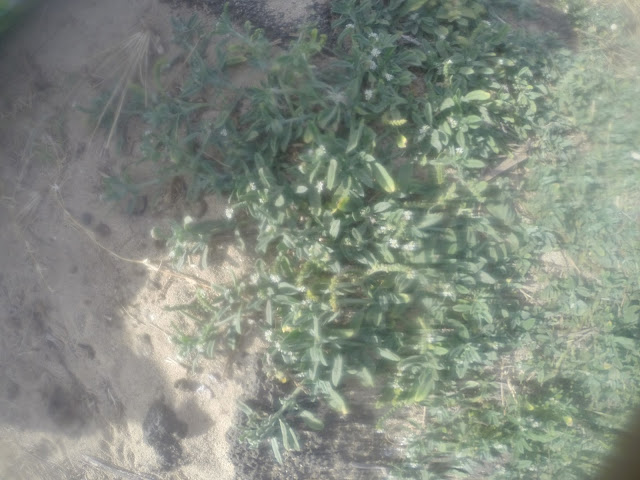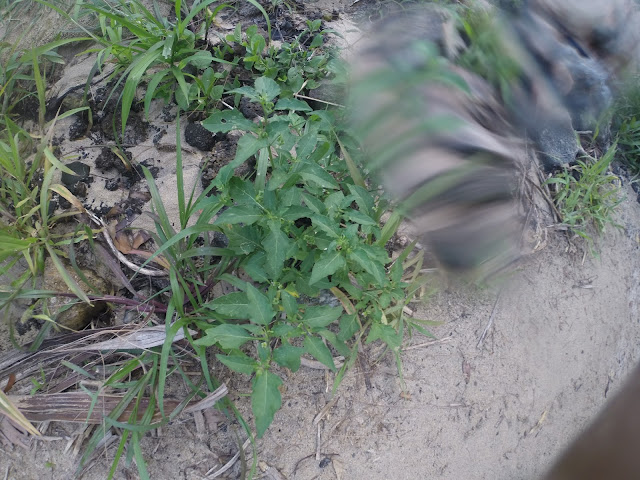Here we have an establishing shot of the beach with some Coconut trees (Cocos nucifera) growing on the edge.
Of course, there is an abundance of Naupaka (Scaevola sericea) on the beach. However, at this site Tree Heliotrope (Tournifortia argentia) is also very abundant. The next 5 photos illustrate this point.
While the photo here is a bit blurry, the narrow leaves and clustered white flowers make me confident that this plant is the Kipukai (Heliotropium curassavicum) which is a native plant that can grow along coastlines or in salt flats.
Here we have the two non-native plants Spanish Needle (Bidens pilosa) with white flowers and Chinese Violet (Asystasia gangetica) with the purple flowers.
Here we have some type of weed (I'll hazard the common yard weed Bermuda grass but the leaves don't look thick enough to me) that is growing between some Pohuehue (Ipomoea pes-caprae).
Another Pohuehue growing between an 'Akia (Wikstroemia uva-ursa) plant. The 'Akia produces a substance that was used to paralyze fish in tidepools by Hawaiian fishermen.
There were some young Ironwood trees (Causuarina equisetifolia) growing near the lifeguard station.
I managed to get a blurry photo of this June Beetle (Oxygrylius ruginasus) crawling along the ground. ID: Bug Guide
A Chinese Violet with white flowers.
A field of Kawelu grass (Eragrostis variabilis) that is characterized by its yellow seed-head or inflorescence.
For these last two plants I could not find a good match in the field guides I am using. In the first one it looks like it is getting ready to flower so had the flowers been out I might have had an easier time with that one.
Summary:
Rating: 4/5
The beach itself was not crowded and is a good spot to wade in the water. There were some interesting plants here during my visit but the majority of plants were naupaka and tree heliotrope. I also enjoyed the scenery of this beach over the other beaches I've gone to so far, so I have to give it points for that. There is also a small island known as rabbit island, named after the rabbit farm that used to exist there. Now it is managed as a seabird sanctuary as seabirds use the island for nesting (source).
Web Sources:
Brown, Mark H. "Reddish June Beetle - Oxygrylius Ruginasus - BugGuide.Net." Reddish June Beetle - Oxygrylius Ruginasus - BugGuide.Net. Iowa State University Department of Entomology, 8 Oct. 2013. Web. 26 Mar. 2016.
"Rabbit Island." Rabbit Island, Oahu. To-Hawaii.com, n.d. Web. 26 Mar. 2016.



















It's nice that you put in links to helpful sites!
ReplyDelete